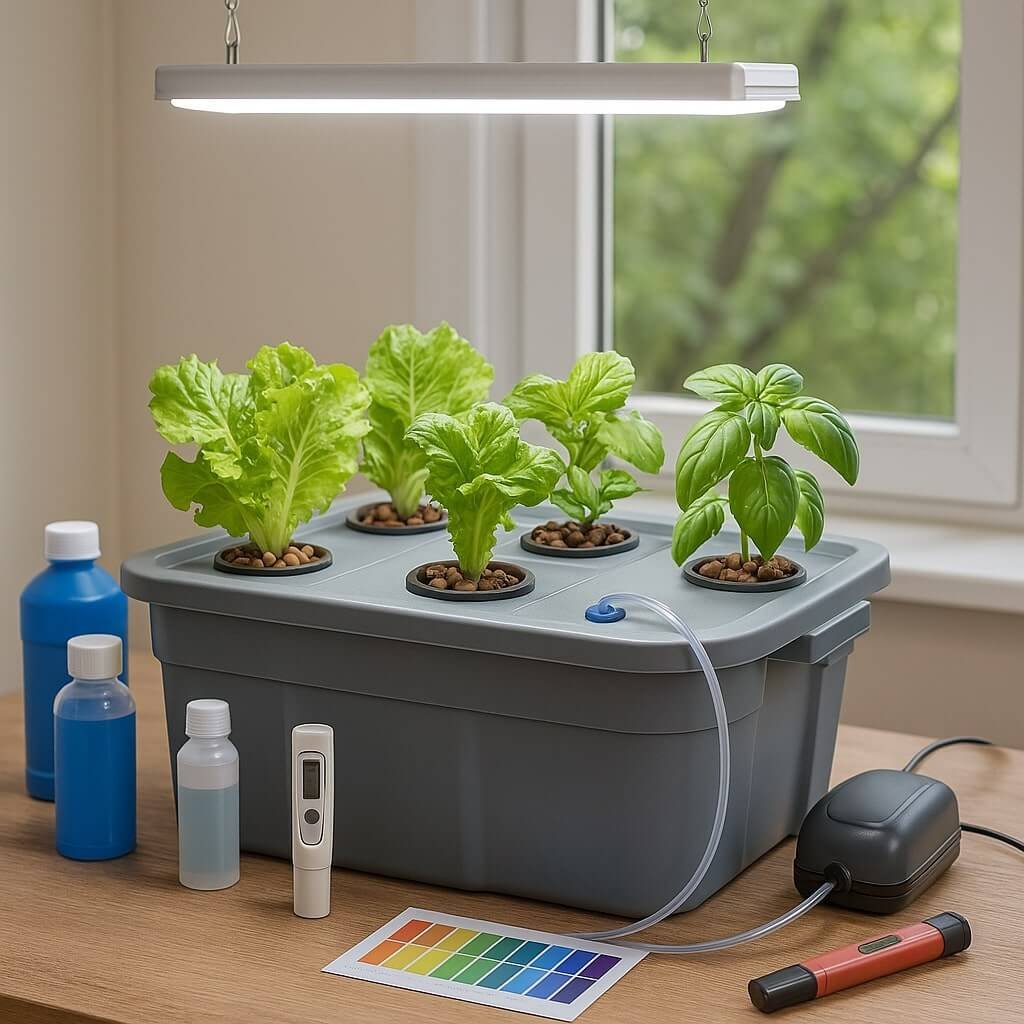What Is Hydroponic Gardening?
Hydroponic gardening is a method of growing plants without soil. Instead, it uses nutrient-rich water to deliver essential minerals directly to plant roots. This technique allows for faster growth, higher yields, and efficient use of space and water.
🌟 Why Choose Hydroponics?
- Space-saving: Ideal for small apartments or urban homes.
- Water-efficient: Uses up to 90% less water than traditional gardening.
- Year-round growth: Controlled indoor environments allow continuous harvesting.
- Fewer pests and weeds: No soil means fewer unwanted guests.
🛠️ Step-by-Step Setup Guide for Beginners
1. 🏡 Choose Your Location
Pick a well-ventilated indoor space with access to electricity. A sunny windowsill, balcony, or spare room works perfectly. If natural light is limited, invest in grow lights.
2. ⚙️ Select a Hydroponic System
Here are beginner-friendly systems to consider:
| System Type | Description | Best For |
|---|---|---|
| Wick System | Uses a wick to draw nutrients to roots. No electricity needed. | Herbs, microgreens |
| Deep Water Culture | Roots float in nutrient solution with air pump for oxygen. | Lettuce, spinach |
| Ebb and Flow | Nutrient solution floods and drains periodically. | Tomatoes, peppers |
| Countertop Kits | All-in-one kits with lights and nutrients. | Small indoor setups |
3. 🧪 Gather Essential Supplies
- Reservoir container
- Air pump and stone (for oxygenation)
- Net pots and growing medium (e.g., clay pellets, rockwool)
- Hydroponic nutrients
- pH testing kit
- Grow lights (LED preferred)
4. 🧬 Mix Nutrient Solution
Follow the instructions on your nutrient mix. Ideal pH range: 5.5 to 6.5. Use a pH meter to adjust levels with pH up/down solutions.
5. 🌱 Plant Your Seeds or Seedlings
Start with easy-to-grow plants:
- Leafy greens: Lettuce, kale, Swiss chard
- Herbs: Basil, mint, cilantro
- Microgreens: Quick-growing and nutrient-dense
Place seeds in a starter medium. Once sprouted, transfer to net pots in your system.
6. 💡 Set Up Lighting
Plants need 12–16 hours of light daily. Use full-spectrum LED grow lights for best results. Position lights 6–12 inches above plants.
7. 🔄 Monitor and Maintain
- Check pH and nutrient levels weekly
- Top off water as needed
- Clean system monthly to prevent algae and bacteria
- Watch for pests like aphids or fungus gnats
🌿 Best Plants for Hydroponic Beginners
| Plant Type | Growth Speed | Light Needs | Notes |
|---|---|---|---|
| Lettuce | Fast | Moderate | Ideal for DWC systems |
| Basil | Medium | High | Great for Wick or DWC |
| Spinach | Fast | Moderate | Thrives in cooler temps |
| Mint | Medium | Moderate | Hardy and low-maintenance |
| Microgreens | Very Fast | Low | Ready in 7–10 days |
🧩 Common Challenges & Solutions
❌ Nutrient Imbalance
Fix: Use EC meter to monitor concentration. Adjust with fresh solution.
❌ pH Fluctuations
Fix: Test regularly and use pH adjusters.
❌ Root Rot
Fix: Ensure proper oxygenation and avoid stagnant water.
❌ Light Burn
Fix: Maintain proper distance between lights and plants.
📦 Budget-Friendly Tips
- Repurpose containers for reservoirs
- Use DIY grow lights with LED strips
- Start with a Wick system to avoid pump costs
- Buy seeds in bulk for savings
🧠 FAQs: Hydroponic Gardening for Beginners
Q1: Can I grow hydroponic plants year-round?
Yes! Indoor hydroponic systems allow for continuous growth regardless of season.
Q2: How often should I change the nutrient solution?
Every 2–3 weeks or when EC/pH levels become unstable.
Q3: What’s the easiest hydroponic system for beginners?
The Wick System is simplest—no pumps or electricity required.
Q4: Do hydroponic plants taste different?
They often taste fresher and more vibrant due to controlled nutrient delivery.
Q5: Is hydroponic gardening eco-friendly?
Absolutely. It uses less water, reduces pesticide use, and minimizes land waste.





